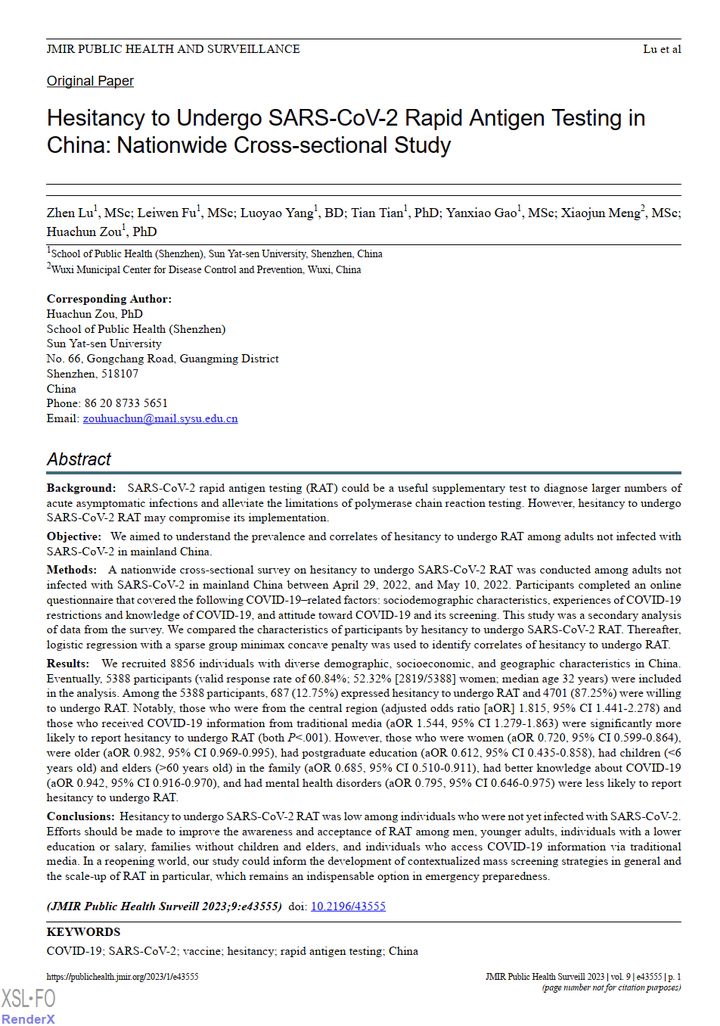Hesitancy to Undergo SARS-CoV-2 Rapid Antigen Testing in China: Nationwide Cross-sectional Study

Abstract
Background: SARS-CoV-2 rapid antigen testing (RAT) could be a useful supplementary test to diagnose larger numbers of acute asymptomatic infections and alleviate the limitations of polymerase chain reaction testing. However, hesitancy to undergo SARS-CoV-2 RAT may compromise its implementation. Objective: We aimed to understand the prevalence and correlates of hesitancy to undergo RAT among adults not infected with SARS-CoV-2 in mainland China. Methods: A nationwide cross-sectional survey on hesitancy to undergo SARS-CoV-2 RAT was conducted among adults not infected with SARS-CoV-2 in mainland China between April 29, 2022, and May 10, 2022. Participants completed an online questionnaire that covered the following COVID-19–related factors: sociodemographic characteristics, experiences of COVID-19 restrictions and knowledge of COVID-19, and attitude toward COVID-19 and its screening. This study was a secondary analysis of data from the survey. We compared the characteristics of participants by hesitancy to undergo SARS-CoV-2 RAT. Thereafter, logistic regression with a sparse group minimax concave penalty was used to identify correlates of hesitancy to undergo RAT. Results: We recruited 8856 individuals with diverse demographic, socioeconomic, and geographic characteristics in China. Eventually, 5388 participants (valid response rate of 60.84%; 52.32% [2819/5388] women; median age 32 years) were included in the analysis. Among the 5388 participants, 687 (12.75%) expressed hesitancy to undergo RAT and 4701 (87.25%) were willing to undergo RAT. Notably, those who were from the central region (adjusted odds ratio [aOR] 1.815, 95% CI 1.441-2.278) and those who received COVID-19 information from traditional media (aOR 1.544, 95% CI 1.279-1.863) were significantly more likely to report hesitancy to undergo RAT (both P<.001). However, those who were women (aOR 0.720, 95% CI 0.599-0.864), were older (aOR 0.982, 95% CI 0.969-0.995), had postgraduate education (aOR 0.612, 95% CI 0.435-0.858), had children (<6 years old) and elders (>60 years old) in the family (aOR 0.685, 95% CI 0.510-0.911), had better knowledge about COVID-19 (aOR 0.942, 95% CI 0.916-0.970), and had mental health disorders (aOR 0.795, 95% CI 0.646-0.975) were less likely to report hesitancy to undergo RAT. Conclusions: Hesitancy to undergo SARS-CoV-2 RAT was low among individuals who were not yet infected with SARS-CoV-2. Efforts should be made to improve the awareness and acceptance of RAT among men, younger adults, individuals with a lower education or salary, families without children and elders, and individuals who access COVID-19 information via traditional media. In a reopening world, our study could inform the development of contextualized mass screening strategies in general and the scale-up of RAT in particular, which remains an indispensable option in emergency preparedness.